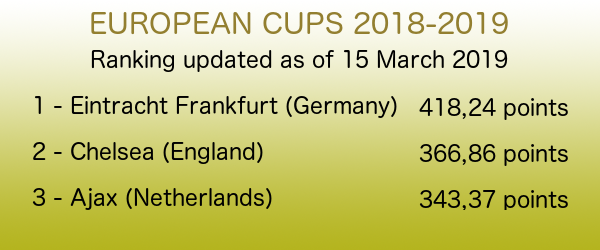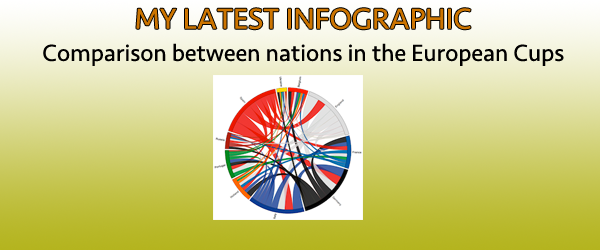
This is the goal distribution, updated as of today, in the top six European football leagues.
The distribution is per segments of 15 minutes, plus the injury time after the 90th minute.
You can find the previous table here.
Now all the countries are aligned regarding the time segment with the fewest goals (first 15 minutes).
![[IMG]](http://nicolacerin.altervista.org/images/Goal_dist_20150115.jpg)

La tabella sopra mostra la distribuzione percentuale delle reti segnati nei 6 principali campionati europei, per ogni segmento di 15 minuti e il recupero dopo il 90° minuto.
I dati sono aggiornati a oggi. La tabella precedente è qui.
Ora tutte le nazioni sono accomunate dall'avere il momento meno prolifico nel primo quarto d'ora di gara.
There could be no need for a ranking to understand which is the best team of 2014: Real Madrid dominated the year, winning the Champions League, the UEFA Super Cup, the FIFA World Cup, the Copa del Rey, and with a 22 wins streak between September and December.
Nevertheless, I decided to create a ranking that considers only the club teams of England, France, Germany, Italy, Portugal and Spain, that played in the top division both in 2013-14 and in 2014-15 seasons.
The calculation system is the following.
Domestic League - points made plus goal difference divided by 2,5; the total is then divided by the number of games played.
European Cup - same as above, but the total is also multiplied (or divided, if negative) by a coefficient, which is:
Champions League 2013-14: 1,3
Europe League 2013-14: 1,2
Champions League 2014-15: 1,2
Europe League 2014-15: 1,1
Furthermore, the scores of all the teams are adjusted to ensure that none of them is negative. The best score remains unchanged, while the worst is converted to 1, and all the other scores are adjusted proportionally. This is the formula to make the adjustment (TS = team score, BS = best score, WS = worst score): TS + ((1-WS)/(BS-WS))*(BS-TS).
The domestic and the European scores are then summed up, and some bonuses are added to the total:
CL winner: 0,50
CL runner-up: 0,40
CL semifinalist: 0,30
EL winner: 0,30
EL runner-up: 0,20
EL semifinalist: 0,10
Domestic league winner: 0,15
Domestic cup winner: 0,05
Domestic Super Cup winner: 0,05
UEFA Super Cup winner: 0,05
FIFA World Cup winner: 0,05
In the table below there are the top 10 teams.
The complete ranking is on this page.
![[IMG]](http://nicolacerin.altervista.org/images/Best2014-Top10.jpg)
Non ci sarebbe bisogno di una classifica per stabilire qual è stata la migliore squadra di club in Europa nel 2014: il Real Madrid ha dominato l'anno, vincendo la Champions League, la Supercoppa europea, la Coppa del Mondo per club e la Coppa del Re, e con una striscia vincente di 22 partite consecutive tra settembre e dicembre.
In ogni caso, ho deciso di creare una classifica che prende in considerazione i club di Inghilterra, Francia, Germania, Italia, Portogallo e Spagna, e che abbiano partecipato al campionato di massima serie sia nel 2013-14 che nel 2014-15.
Il sistema di calcolo è il seguente.
Campionato - punti fatti più la differenza reti divisa per 2,5; il totale è quindi diviso per il numero di partite giocate.
Coppe Europee - come sopra, ma il totale è inoltre moltiplicato (o diviso, se negativo) per un coefficiente, che è:
Champions League 2013-14: 1,3
Europa League 2013-14: 1,2
Champions League 2014-15: 1,2
Europa League 2014-15: 1,1
Inoltre, i punteggi di tutte le squadre sono modificati per assicurare che non ce ne siano di negativi. Il miglior punteggio resta inalterato, il peggiore (se è negativo) viene portato a 1, mentre tutti gli altri vengono modificati in modo proporzionale. Questa è la formula usata per questa regolazione (TS = punteggio della squadra, BS = punteggio migliore, WS = punteggio peggiore): TS + ((1-WS)/(BS-WS))*(BS-TS).
I punteggi di campionato e coppe di ciascuna squadra sono quindi sommati tra di loro, e al totale vengono applicati alcuni bonus::
vincitore CL : 0,50
finalista CL: 0,40
semifinalista CL: 0,30
vincitore EL : 0,30
finalista EL: 0,20
semifinalista EL: 0,10
vincitore del campionato: 0,15
vincitore della coppa nazionale: 0,05
vincitore della supercoppa nazionale: 0,05
vincitore della supercoppa UEFA: 0,05
vincitore della coppa del mondo per club FIFA: 0,05
Nella tabella sopra trovate i migliori 10 club.
In questa pagina c'è la classifica completa.
 The 66% threshold that I put in the ranking showed in the previous post about the equalizers were actually too much restrictive, because many significative results were excluded from the tables.
In the following tables, the threshold is reduced to 50%. This means that, to enter in the ranking, a team has to score or concede a "leading goal" a number of teams equal at least to the 50% of the matches played.
The matches are the same taken into consideration previously, as of the 31st of December.
The 66% threshold that I put in the ranking showed in the previous post about the equalizers were actually too much restrictive, because many significative results were excluded from the tables.
In the following tables, the threshold is reduced to 50%. This means that, to enter in the ranking, a team has to score or concede a "leading goal" a number of teams equal at least to the 50% of the matches played.
The matches are the same taken into consideration previously, as of the 31st of December.
Ability to equalize: in this ranking the leader is now Bayer Leverkusen, who conceded 11 times a goal that gave the lead to their opponents, and 8 times they were able to equalize it.
![[IMG]](http://nicolacerin.altervista.org/images/Equalizer-ate-20150101.jpg)
Opponent's ability to equalize: Guimaraes and Malaga didn't concede any equalizer to the opponent teams, after having taken the lead 8 and 9 times, respectively.
![[IMG]](http://nicolacerin.altervista.org/images/Equalizer-oate-20150101.jpg) La soglia del 66% che avevo considerato nel precedente post riguardo agli equalizers era effettivamente troppo restrittiva, poiché molti risultati significativi sono stati esclusi dalla classifica.
Nelle due tabelle soprastanti, la soglia è ridotta al 50%. Ciò significa che, per entrare in classifica, una squadra deve avere segnato o concesso all'avversario il gol del vantaggio un numero di volte pari almeno alla metà delle partite giocate.
Le partite prese in considerazione sono le stesse del post sottostante, al 31 dicembre.
La soglia del 66% che avevo considerato nel precedente post riguardo agli equalizers era effettivamente troppo restrittiva, poiché molti risultati significativi sono stati esclusi dalla classifica.
Nelle due tabelle soprastanti, la soglia è ridotta al 50%. Ciò significa che, per entrare in classifica, una squadra deve avere segnato o concesso all'avversario il gol del vantaggio un numero di volte pari almeno alla metà delle partite giocate.
Le partite prese in considerazione sono le stesse del post sottostante, al 31 dicembre.
Abilità di pareggiare (prima tabella): in questa classifica la squadra leader è adesso il Bayer Leverkusen, che ha concesso 11 volte una rete che ha portato in vantaggio l'avversario, riuscendo però a recuperare per 8 volte.
Capacità di non concedere il gol del pareggio all'avversario (seconda tabella): il Guimaraes e il Malaga non hanno mai subito alcun gol del pareggio finora, dopo essere passati in vantaggio rispettivamente 8 e 9 volte.

![[IMG]](http://nicolacerin.altervista.org/images/Goal_dist_20150115.jpg)






![[IMG]](http://nicolacerin.altervista.org/images/Best2014-Top10.jpg)
![[IMG]](http://nicolacerin.altervista.org/images/Equalizer-ate-20150101.jpg)
![[IMG]](http://nicolacerin.altervista.org/images/Equalizer-oate-20150101.jpg)